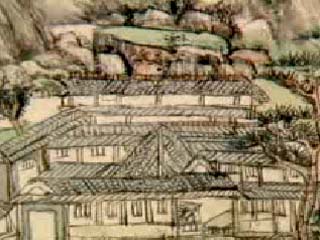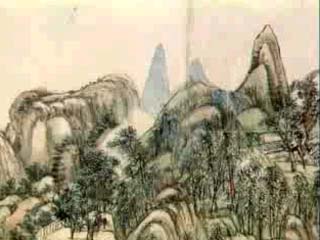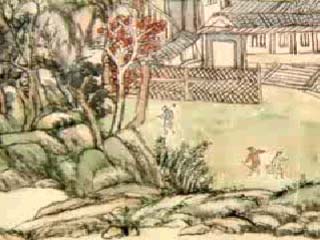In his poetry Wang is a master of illusion and can describe in one
line a landscape so real that if you close your eyes, you can take yourself
there. Because he is a painter as well as a poet, he pictures the
landscape when he writes and can point out those intimate details that
pull and tug at your emotions, leaving you entranced while standing at
the foot of his beautifully created mural. Combining his amazing
talent with words and his ability to paint a landscape so serene that it
has “miraculous” effects, can create an illusion so real it may leave the
viewer in a state of awe. Su Shi, in the 11th century, wrote a poem
comparing Wu Daozi and Wang Wei, and in it he said, “I have seen the two
masters: both are divinely talented. But as for Wei, I step back
without a word” (Harrist 70).
 Wang’s work is
largely a reflection of the attitudes and culture of the Tang Dynasty (618-907).
Emperor Taizong (600-649) held the belief that “Literary arts and military
arts should be employed by the state alternately” (Ebrey 115). The
Tang was a time of peace, which allowed art and culture to prosper.
The security of a stable environment created a nurturing climate for artists,
scholars and poets alike. The poetry that was written during the
Tang Dynasty is so superior that it is used as a benchmark to judge all
Chinese poetry both before and after its time (Yang 91). Wang’s work is
largely a reflection of the attitudes and culture of the Tang Dynasty (618-907).
Emperor Taizong (600-649) held the belief that “Literary arts and military
arts should be employed by the state alternately” (Ebrey 115). The
Tang was a time of peace, which allowed art and culture to prosper.
The security of a stable environment created a nurturing climate for artists,
scholars and poets alike. The poetry that was written during the
Tang Dynasty is so superior that it is used as a benchmark to judge all
Chinese poetry both before and after its time (Yang 91).
A hallmark of the Tang Dynasty was the development of government. The
state of Tang government is also be reflected in art. For instance,
the Tang Dynasty was the first in which exams were an important step to
becoming an official. The exams consisted mostly of memorization
of the classics and literary composition, creating a higher need for education
among officials. This and the Tang Legal Code, issued in 653, provided
rules and procedures for officials to follow (Ebrey 116). The Code
and the examination system created a very structured and strict political
life encouraging officials to turn to art, poetry and literature as a means
of relaxation and an escape from their everyday lives. Wang, like
many officials of his time and wrote of a life without the constraints
and complications of political life. Many of his poems create the
image of a simple, but happy life.
A majority of Wang’s paintings are characteristically Chinese, in that
they have many focal points, as opposed to the standard one focal point
in Western paintings. Multiple focal points provide the perception
of softness and tranquillity. Another reflective aspect of his style
is the inclusion of a water landscape. Many of the winter scenes
have water, even though one would assume that water would be frozen over.
Water has a very calming effect that adds to the peacefulness of the landscape,
many of which are in monochrome, bland colors. This is also characteristic
of the serene environment because the bland colors symbolize serenity and
realism. A landscape is a small piece of nature and it is characteristically
peaceful; which could explain why landscape painting became so popular
during this time period.
Painting and poetry are both used to express feelings, so it is only
natural that the two should be combined to express emotion of a deeper
level. However, this evolution relied on the Tang philosophy that
scholars and officials were defined by their talent as writers and poets.
If writing and poetry were not of great importance in Tang culture, Wang
might not have ventured to combine the two. The freedom of expression
that was present during this time is also a factor that allowed wen ren
hua painting to become an important part of art culture.
During the Tang, Buddhism flourished. Emperor Taizong, in the
early Tang, believed “The Way” was spread through culture (Ebrey 115).
Wei Shou, a 6th Century Historian, wrote that one of the steps to attaining
Buddhahood is practicing serenity (Ebrey 98). It is these Buddhist views
that were to set the atmosphere for the Tang Dynasty
and made culture an important part of Chinese life.
Wang used a very simplistic language that created “a vision of the world
that was uniquely his own” (Owen 385). This vision is established
by Wang’s Buddhist perception that the world is only illusions of the human
senses. He wrote passionate poetry that played on almost all human
senses: sight, sound, touch and smell. Wang’s poem "Autumn Evening
in the Mountains" displays his use of the human senses to create an illusion
of reality and simplicity.
Autumn Evening in the Mountains
After the rain
That covered these mountains the night air
Smells of fall
The moon gleams
Among long-needled pines
Rushing softly across its rocks
The creek
Glitters
Bringing their laundry home
Through the bamboos
Women chatter
A fisherman poles his boat
Through the heavy lotus leaves
Swaying
The spring flowers
And their heavy odors
Are gone
Stick around anyway
Old friend
For the beauty of fall.
The first line is simple, yet it sets the mood for the rest of the poem.
Everyone knows what it is like after the rain. You can picture the
last time you walked outside after it rained and you remember what it looked,
smelled and felt like. Even if the reader has never been in the mountains
they can still picture the scenery of the poem and they can feel what it
is like to be there because Wang creates a mood that everyone can relate
to. The third line is also very plain, but by using a familiar smell,
he creates an image that is very real. The oversimplification allows
nature to speak for itself.
Sound is a sense that is sometimes over-looked in poetry. In this
poem Wang uses sound as a sort of background that helps bring the poem
to life. There are other people in the poem; women walking through
the woods and a fisherman paddling his boat. The combination of other
actions and the sound of the women talking in the background, gives the
reader the feeling of sitting still in the landscape while everything is
going on around them.
In this poem, Wang speaks of the uncomplicated lives of hunters, fishermen
and farmers. These were some of the first careers for men and although
they involve hard manual-labor, which Wang does not elude to in his poems,
they are simplistic and allow a man to live alone, among nature.
Wang perceives these careers and nature as pure, simple and perfect.
He has an idealistic perception of a simple life.
It is said that a great Chinese landscape painting has the power to
let you escape from reality. Landscape painting, also and poetry,
is “recognized as a source of spiritual solace and refreshment,” which
suggests officials can nourish their spirit by taking imaginary journeys
through landscape art (Owen 385). Wang, born in to a high position
in society and had a political career, must have felt very constrained
by the requirements of his hectic life. This stress is why he turned to
poetry and art as an idealistic escape from his daily life and career.
Almost all of his poems about nature bring about a very serene, calm feeling,
allowing him to use his art to escape his life. Wang’s work is a
direct contradiction of his lifestyle. The landscapes and places
he speaks of in his poem are not at all what he would experience at work
or a high-society social gathering.
Autumn Evening in the Mountains may be a symbolic cleansing of Wang’s
life. Wang portrays the purity and innocence of the country atmosphere
once it has been cleansed by the rain, making reference to the idea of
cleansing himself of the effects of being a political official. “The
heavy odors are gone” could be a reference to the corruption of the political
environment that surrounded him. It is logical to believe that poetry
and art helped to cleanse Wang’s soul.
|
 This paper
will explore Wang Wei and his many accomplishments. He is famous
for being not only a great artist, but also a calligrapher, musician and
talented poet. Wang’s work is largely a reflection of the attitudes and
culture of the Tang Dynasty (618-907). The themes of the time period
are prevalent in his creations. Wang Wei is considered the founding
father of landscape painting and during his lifetime created a new style
of art called wen ren hua. Wang Wei is an intricate part of
Chinese art and literary history, leaving behind some four hundred poems
and an entirely new style of painting.
This paper
will explore Wang Wei and his many accomplishments. He is famous
for being not only a great artist, but also a calligrapher, musician and
talented poet. Wang’s work is largely a reflection of the attitudes and
culture of the Tang Dynasty (618-907). The themes of the time period
are prevalent in his creations. Wang Wei is considered the founding
father of landscape painting and during his lifetime created a new style
of art called wen ren hua. Wang Wei is an intricate part of
Chinese art and literary history, leaving behind some four hundred poems
and an entirely new style of painting.
 Wang’s work is
largely a reflection of the attitudes and culture of the Tang Dynasty (618-907).
Emperor Taizong (600-649) held the belief that “Literary arts and military
arts should be employed by the state alternately” (Ebrey 115). The
Tang was a time of peace, which allowed art and culture to prosper.
The security of a stable environment created a nurturing climate for artists,
scholars and poets alike. The poetry that was written during the
Tang Dynasty is so superior that it is used as a benchmark to judge all
Chinese poetry both before and after its time (Yang 91).
Wang’s work is
largely a reflection of the attitudes and culture of the Tang Dynasty (618-907).
Emperor Taizong (600-649) held the belief that “Literary arts and military
arts should be employed by the state alternately” (Ebrey 115). The
Tang was a time of peace, which allowed art and culture to prosper.
The security of a stable environment created a nurturing climate for artists,
scholars and poets alike. The poetry that was written during the
Tang Dynasty is so superior that it is used as a benchmark to judge all
Chinese poetry both before and after its time (Yang 91).

 Wang Wei is
an intricate part of Chinese art and literary history, leaving behind some
four hundred poems and an entirely new style of painting. He has
a very simple and unique form that helped to shape art and poetry for many
generations. Wang had a kind of passion and regard for words that
flow out of his poetry and effect anyone who reads his work. Although
he never followed the trend of his time and left his position to live the
life he created in his poetry, he actualized exquisite scenery and emotional
poetry. His poetry was an escape for him and a beautiful journey
for thousands of others who enjoy his simple, serene verse.
Wang Wei is
an intricate part of Chinese art and literary history, leaving behind some
four hundred poems and an entirely new style of painting. He has
a very simple and unique form that helped to shape art and poetry for many
generations. Wang had a kind of passion and regard for words that
flow out of his poetry and effect anyone who reads his work. Although
he never followed the trend of his time and left his position to live the
life he created in his poetry, he actualized exquisite scenery and emotional
poetry. His poetry was an escape for him and a beautiful journey
for thousands of others who enjoy his simple, serene verse.